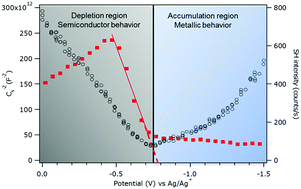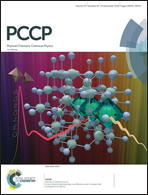Non-parabolic potential dependence of optical second harmonic generation from the Si(111) electrode/electrolyte interface†
Abstract
We performed potential dependent second harmonic generation (SHG) measurements on the Si(111) electrolyte interface at different azimuthal angles and for different polarization combinations. When the external potential was biased from the equilibrium potential to the flatband potential (Efb), the SHG intensity decreased linearly with the potential when the azimuthal angle was oriented at 30°. This linearity extends well beyond the linear region of the Mott–Schottky plot as measured traditionally by capacitance measurements. When the external potential was scanned from Efb toward more negative potentials, the response of SHG intensity showed quadratic behavior and can be described by the parabolic model. The non-parabolic potential dependence cannot be explained with the parabolic model proposed from previous literature. Such asymmetric behavior only implied that the interfacial structure of the Si(111) electrode changes from semiconductor to metal with the applied electric potential biased negatively, i.e. with accumulation of electrons in the surface region. The anisotropic contribution from the Si(111) electrode can also significantly affect the SHG response as seen where the minimum of the potential dependent SHG curve shifts away from Efb.



 Please wait while we load your content...
Please wait while we load your content...